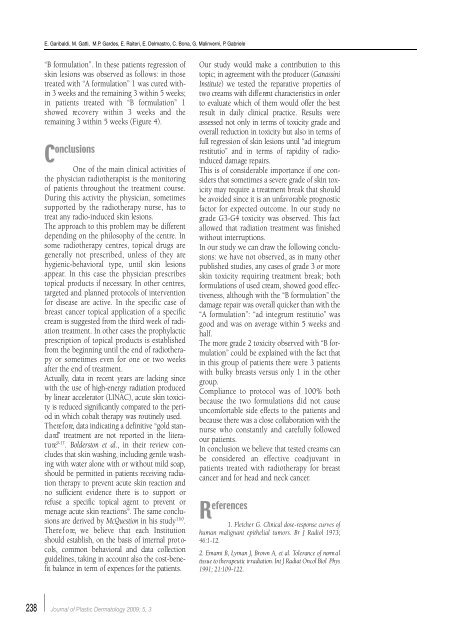Vol. 5, n. 3, September-December 2009 - Salute per tutti
Vol. 5, n. 3, September-December 2009 - Salute per tutti
Vol. 5, n. 3, September-December 2009 - Salute per tutti
You also want an ePaper? Increase the reach of your titles
YUMPU automatically turns print PDFs into web optimized ePapers that Google loves.
E. Garibaldi, M. Gatti, M.P. Gardes, E. Raiteri, E. Delmastro, C. Bona, G. Malinverni, P. Gabriele<br />
“B formulation”. In these patients regression of<br />
skin lesions was observed as follows: in those<br />
treated with “A formulation” 1 was cured within<br />
3 weeks and the remaining 3 within 5 weeks;<br />
in patients treated with “B formulation” 1<br />
showed re c o v e ry within 3 weeks and the<br />
remaining 3 within 5 weeks (Figure 4).<br />
C onclusions<br />
One of the main clinical activities of<br />
the physician radiotherapist is the monitoring<br />
of patients throughout the treatment course.<br />
During this activity the physician, sometimes<br />
supported by the radiotherapy nurse, has to<br />
treat any radio-induced skin lesions.<br />
The approach to this problem may be different<br />
depending on the philosophy of the centre. In<br />
some radiotherapy centres, topical drugs are<br />
generally not prescribed, unless of they are<br />
hygienic-behavioral type, until skin lesions<br />
appear. In this case the physician prescribes<br />
topical products if necessary. In other centres,<br />
targeted and planned protocols of intervention<br />
for disease are active. In the specific case of<br />
breast cancer topical application of a specific<br />
cream is suggested from the third week of radiation<br />
treatment. In other cases the prophylactic<br />
prescription of topical products is established<br />
from the beginning until the end of radiotherapy<br />
or sometimes even for one or two weeks<br />
after the end of treatment.<br />
A c t u a l l y, data in recent years are lacking since<br />
with the use of high-energy radiation pro d u c e d<br />
by linear accelerator (LINAC), acute skin toxicity<br />
is reduced significantly compared to the <strong>per</strong>iod<br />
in which cobalt therapy was routinely used.<br />
T h e re f o re, data indicating a definitive “gold stand<br />
a rd” treatment are not reported in the literat<br />
u re 9 - 17 . Bolderston et al., in their review concludes<br />
that skin washing, including gentle washing<br />
with water alone with or without mild soap,<br />
should be <strong>per</strong>mitted in patients receiving radiation<br />
therapy to prevent acute skin reaction and<br />
no sufficient evidence there is to support or<br />
refuse a specific topical agent to prevent or<br />
menage acute skin re a c t i o n s 9 . The same conclusions<br />
are derived by M c Q u e s t i o n in his study 11 ì 0 .<br />
T h e re f o re, we believe that each Institution<br />
should establish, on the basis of internal pro t o-<br />
cols, common behavioral and data collection<br />
guidelines, taking in account also the cost-benefit<br />
balance in term of expences for the patients.<br />
Our study would make a contribution to this<br />
topic; in agreement with the producer (G a n a s s i n i<br />
I n s t i t u t e) we tested the reparative pro<strong>per</strong>ties of<br />
two creams with diff e rent characteristics in ord e r<br />
to evaluate which of them would offer the best<br />
result in daily clinical practice. Results were<br />
assessed not only in terms of toxicity grade and<br />
overall reduction in toxicity but also in terms of<br />
full re g ression of skin lesions until “ad integrum<br />
restitutio” and in terms of rapidity of radioinduced<br />
damage repairs.<br />
This is of considerable importance if one considers<br />
that sometimes a severe grade of skin toxicity<br />
may require a treatment break that should<br />
be avoided since it is an unfavorable prognostic<br />
factor for expected outcome. In our study no<br />
grade G3-G4 toxicity was observed. This fact<br />
allowed that radiation treatment was finished<br />
without interruptions.<br />
In our study we can draw the following conclusions:<br />
we have not observed, as in many other<br />
published studies, any cases of grade 3 or more<br />
skin toxicity requiring treatment break; both<br />
formulations of used cream, showed good effectiveness,<br />
although with the “B formulation” the<br />
damage repair was overall quicker than with the<br />
“A formulation”: “ad integrum restitutio” was<br />
good and was on average within 5 weeks and<br />
half.<br />
The more grade 2 toxicity observed with “B formulation”<br />
could be explained with the fact that<br />
in this group of patients there were 3 patients<br />
with bulky breasts versus only 1 in the other<br />
group.<br />
Compliance to protocol was of 100% both<br />
because the two formulations did not cause<br />
uncomfortable side effects to the patients and<br />
because there was a close collaboration with the<br />
nurse who constantly and carefully followed<br />
our patients.<br />
In conclusion we believe that tested creams can<br />
be considered an effective coadjuvant in<br />
patients treated with radiotherapy for breast<br />
cancer and for head and neck cancer.<br />
R eferences<br />
1. Fletcher G. Clinical dose-response curves of<br />
human malignant epithelial tumors. Br J Radiol 1973;<br />
46:1-12.<br />
2. Emami B, Lyman J, Brown A, et al. Tolerance of norm a l<br />
tissue to therapeutic irradiation. Int J Radiat Oncol Biol Phys<br />
1991; 21:109-122.<br />
238<br />
Journal of Plastic Dermatology <strong>2009</strong>; 5, 3

















